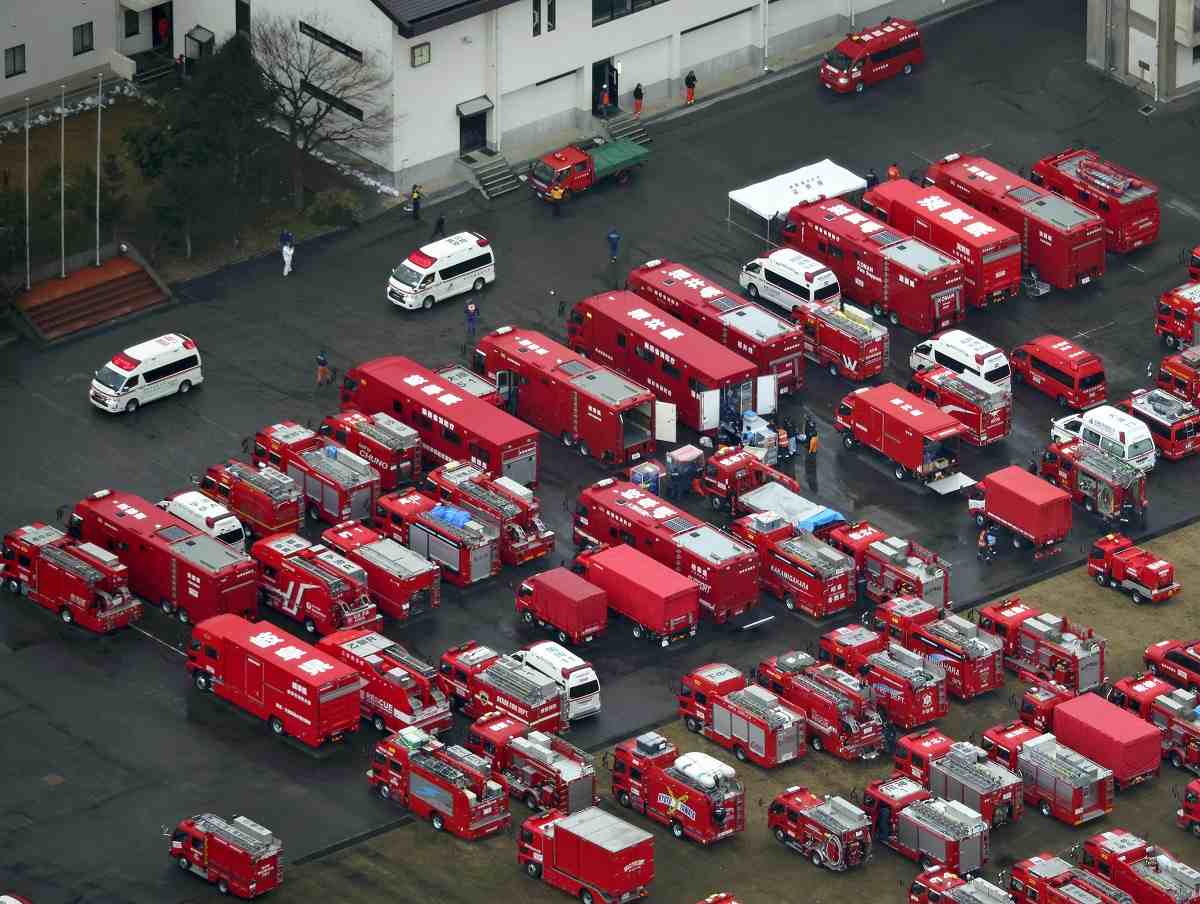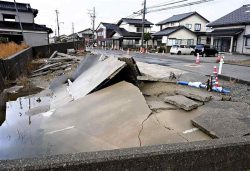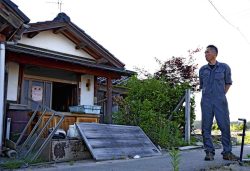Noto Quake — A Closer Look / Blocked Roads Thwart Plans by Response Teams to Quickly Access Quake-Hit Noto; Hospitals Struggled to Cope

Firefighting and other vehicles belonging to emergency fire response teams dispatched from various parts of Japan fill a parking lot in Kanazawa on Jan. 3.
7:00 JST, February 2, 2024
Wreckage of homes swept away by tsunami and debris from capsized boats littered the water’s surface, blocking the Maritime Self-Defense Force destroyer Asagiri from getting close enough to dock at Iida Port in Suzu, Ishikawa Prefecture, on Jan. 2.
On board the ship was Hirofumi Oda from the Otsu Fire Department and was the head of Shiga Prefecture’s emergency fire response team that had been an advanced unit attempting to reach Suzu, which had been pummeled by the Noto Peninsula Earthquake the previous day. Oda, 58, could not contain his frustration at being unable to get to the city.
“Oh, it’s right there,” Oda said. It was now the evening, and the clock was ticking toward the 72-hour mark, when survival rates after a disaster begin to drop off.
A helicopter aboard the Asagiri was able to land in Suzu on the morning of Jan. 3. However, the helicopter’s weight restrictions meant that Oda and the other response team members could only take items such as crowbars and saws with them.
Oda faced an agonizing decision when the team arrived at a house in which an elderly woman was trapped under the wreckage. A rescue team member attempted to crawl inside the wrecked home, but could only squeeze less than half of his body into a gap. Oda also was worried that an aftershock could bring down the rest of the house and bury his team member. “Without heavy machinery, it’s difficult to do more than this,” Oda said to the woman’s family, who were watching on. Their response was completely unexpected.
“Thank you for doing as much as you have for us,” one of the woman’s relatives said.
Oda regrets that he could not do more. “There was a ‘blank period’ when we couldn’t even enter the disaster-hit area,” Oda said. “We didn’t have enough equipment, so I’m not sure how much we were really able to help people there.”
Emergency fire response teams are units dispatched to disaster-hit areas from fire departments across Japan, and are mobilized when requested by the Fire and Disaster Management Agency commissioner and through other channels. Established in 1995 based on lessons learned during the Great Hanshin Earthquake of the same year, the role of these teams was spelled out in the 2004 Fire and Disaster Management Organization Law. There were about 25,000 people making up 6,629 such teams across the nation as of April 2023. The Noto Peninsula Earthquake marked the 44th time these units had been mobilized.
On Jan. 1, the day the quake struck, a total of about 2,000 people in emergency fire response teams from 11 prefectures were mobilized to Ishikawa Prefecture. About 600 of these from four prefectures, including Shiga, set out for Suzu. However, National Highway 249 and all other roads to Suzu were impassable due to the earthquake. Not a single response team member reached Suzu on Jan. 1 and only about 20 that were flown in got on the ground there the following day. It was on the evening of Jan. 3 — about 48 hours after the quake struck — that 1,000 members, including some from two other prefectures, actually had their boots on the ground in Suzu.
In November 2023, response teams from Ishikawa Prefecture and the Chubu region had conducted a joint training exercise on Noto Peninsula. This exercise, just weeks before the Jan. 1 disaster, simulated the response after an earthquake measuring upper 6 on the Japanese seismic intensity scale of 7 had hit the town of Noto in the prefecture, triggering a tsunami and starting fires. About 500 response team members participated in this exercise, but there was one glaring oversight. “We never considered a situation in which we couldn’t assemble in an area because the roads had been cut off,” one member said.
This might not be the only time when a disaster-hit area essentially becomes an “isolated island on land.” A 53-year-old firefighter from the Shizuoka City Fire Bureau who was dispatched to Suzu as part of a Shizuoka Prefecture emergency fire response team, was concerned about what had occurred on Noto Peninsula. “Shizuoka Prefecture includes Izu Peninsula,” he said. “We must learn lessons from the Noto Peninsula Earthquake and think about how we could send in support teams” on the Izu Peninsula.
Hospitals’ plans also come up short
Disaster base hospitals, which provide medical treatment in times of disaster, also struggled to cope with the aftermath of the earthquake.
The quake’s intense shaking damaged the walls at the entrance of Wajima Municipal Hospital, one of two disaster base hospitals covering two cities and two towns in the Okunoto area on the peninsula’s northern tip. Equipment used for testing blood, urine and performing other checks was also smashed at the 175-bed four-story hospital. The water supply was cut off, making it impossible to conduct medical checkups and surgeries that required water.
A stream of injured people poured into the hospital, so doctors and other medical personnel set up a triage area in a corner of the parking lot to determine which patients should get priority. The injured were given one of four colored tags depending on the severity of their wounds. Most were given a green tag, for light injuries, or yellow, which indicated the patient could wait for medical treatment. But by late that night, six patients had received a red tag specifying they needed treatment immediately, and six that had no chance of survival had been given a black tag.
“We hadn’t anticipated a situation in which we feared the hospital’s medical functions might crumble,” said Kuniyuki Kawasaki, general manager at Wajima Municipal Hospital. The hospital’s business continuity plan in the event of a major disaster assumed that all of the about 200 staffers would make their way to the hospital after a quake measuring upper 5 or higher on the Japanese scale. However, many of these staffers also fell victim to this earthquake. One nurse took four hours to reach the hospital, even climbing over a cliff on the way. In the end, only about 30 personnel, including doctors and nurses who had already been at work on New Year’s Day, were able to arrive at the hospital.
At the moment the earthquake struck, 110 patients had been staying at the hospital for treatment. There were fears the remaining empty beds would soon fill up. “We’ll be stretched past breaking point if things carry on like this,” Kawasaki recalled thinking.
The following day, Jan. 2, at the instruction of a Disaster Medical Assistance Team (DMAT) that had come from Gifu and other prefectures, all of the hospital’s inpatients were taken to other hospitals both inside and outside Ishikawa Prefecture over the following three days. “I think the medical treatment system might’ve collapsed without the DMAT’s assistance,” Kawasaki said.
Maintaining the functions of hospitals in the Okunoto area has its difficulties even during normal times. Kazukimi Ishii, director general of Suzu General Hospital, the second disaster base hospital in the area, is worried about whether the hospital will be able to retain enough manpower.
“Many of our employees were hit hard by the quake and will leave Suzu,” said Ishii, 58.
How can residents’ lives be protected when a massive disaster strikes a sparsely populated area? Yoshiteru Murosaki, professor emeritus of Kobe University and an adviser to Ishikawa Prefecture on disaster crisis management, insists a multipronged approach will be needed.
“Increasing the number of personnel at fire departments and hospitals in sparsely populated areas is difficult,” Murosaki said. “It’s crucial to bolster the medical system and firefighting equipment so that people brought in from other areas to assist can quickly get to work. This isn’t something municipal governments should handle on their own. Rather, the central government needs to provide funding to help tackle this issue.”
"Society" POPULAR ARTICLE
-

M4.9 Earthquake Hits Tokyo, Neighboring Prefectures
-

M7.5 Earthquake Hits Northern Japan; Tsunami Waves Observed in Hokkaido, Aomori and Iwate Prefectures
-

Israeli Tourists Refused Accommodation at Hotel in Japan’s Nagano Pref., Prompting Protest by Israeli Embassy and Probe by Prefecture
-

Tsukiji Market Urges Tourists to Avoid Visiting in Year-End
-

M5.7 Earthquake Hits Japan’s Kumamoto Pref., Measuring Upper 5 Intensity, No Tsunami Expected
JN ACCESS RANKING
-

Keidanren Chairman Yoshinobu Tsutsui Visits Kashiwazaki-Kariwa Nuclear Power Plant; Inspects New Emergency Safety System
-

Imports of Rare Earths from China Facing Delays, May Be Caused by Deterioration of Japan-China Relations
-

University of Tokyo Professor Discusses Japanese Economic Security in Interview Ahead of Forum
-

Japan Pulls out of Vietnam Nuclear Project, Complicating Hanoi’s Power Plans
-

Govt Aims to Expand NISA Program Lineup, Abolish Age Restriction
























